How to Measure Influencer Performance?
Over the last few years, the influencer and ambassador marketing sector has grown tremendously. Budgets are easier to come by. Work is more reliable. We rely on honest and fair contractual agreements rather than PR boxes. Brands and influencers work with a mindset that is less transactional and more focused on building long-term relationships. There are numerous examples of this functioning, but measuring remains a conundrum.
Defining Success
What is the maximum speed at which a human should be able to run a mile? It’s a tough question because it necessitates further inquiry. What is this person’s age? Are they going uphill or downhill? Are they attempting to run the mile as quickly as possible, or are they attempting to establish a long-term habit?
The same can be said for influencer marketing, and it should be. We have a fixation with broad norms, average engagements, and misguided attempts at uniformity in our sector.
We compromise our long-term success in our pursuit of short-term high performance and often misguided goals. In order for brands to prepare for a future in which influencer and ambassador marketing is the most prevalent form of marketing, a continual goal must be to learn, grow, and innovate.
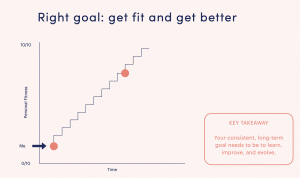
Data to Build From
The following charts represent data taken from over 20,000 accounts over the course of 2021. This data can be used to: Assess your campaign’s performance versus the broader industry Manage expectations with your team, boss or clients. Determine whether your go-to influencers are above or below industry medians.
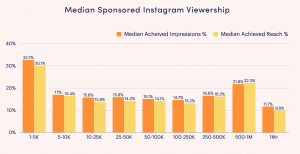

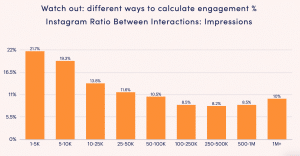
Measuring Goals Down the Funnel
Advertising theory tells us that a consumer needs to see a product 6-7 times before pulling the trigger. Use this funnel to help guide you through which metrics to optimize for and focus on when mapping back to your goals. Set your goals and KPIs before commencing influencer identification to ensure you are selecting the right partners.
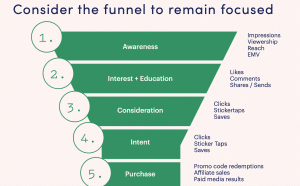
The Four C’s of Benchmarking
Benchmark is defined as “Evaluate or check (something) by comparison with a standard.” But what is the standard? “Standard” does not and should not simply refer to industry medians.

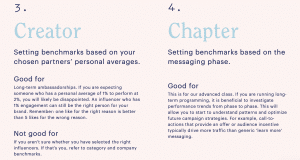
Four Tips for Telling Stories of Success
- Consider your own consumer behavior to set expectations. Often, influencers are the first click and not the last click.
- Make data digestible. Big numbers can be tough to comprehend or understand. Consider bringing a key data point into the real world by comparing it to a landmark people can visualize. For example: “Imagine filling Wrigley Field stadium, putting someone in the middle which the whole audience deeply trusts, and having them explain why Dyson is so great. We did that 187 times.”
- The specific is universal. Sometimes one great comment can tell a more impactful success story than a whole slide of stats. The zoom-out is important, but so is the zoom-in.
- Analyze the all-stars. Study the high performers to see what you think drove it. Averages and medians tell us what we did, outliers tell us what we can do. By showing your team what a knock-out-of-the-park post looks like, you’ll ignite excitement about what’s possible for next time.
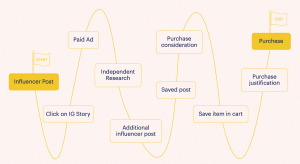
![digital marketing agency toronto digital marketing toronto digital marketing jobs toronto digital marketing company toronto digital marketing agencies toronto toronto digital marketing agency digital marketing course toronto digital marketing courses toronto toronto digital marketing digital marketing agency in toronto digital marketing companies toronto digital marketing companies in toronto toronto digital marketing company digital marketing company in toronto digital marketing internship toronto digital marketing jobs in toronto best digital marketing agency toronto digital marketing salary toronto digital marketing firms toronto university of toronto digital marketing digital marketing in toronto toronto digital marketing firm digital marketing service toronto digital marketing university of toronto digital marketing job toronto digital marketing coordinator salary toronto digital marketing firm toronto digital marketing conference toronto university of toronto digital marketing certificate entry level digital marketing jobs toronto top digital marketing agencies in toronto digital marketing agencies in toronto digital marketing jobs toronto entry level digital marketing toronto milliondev digital marketing certificate toronto best digital marketing agencies in toronto digital marketing specialist salary toronto digital marketing services in toronto digital marketing services toronto digital marketing bootcamp toronto digital marketing specialist toronto digital marketing manager salary toronto digital marketing programs toronto digital marketing program toronto digital marketing course in toronto toronto digital marketing jobs digital marketing toronto jobs digital marketing consultant toronto digital marketing company toronto milliondev masters in digital marketing toronto digital marketing courses in toronto top digital marketing agencies toronto digital marketing diploma toronto best digital marketing agency in toronto toronto digital marketing consultant toronto digital marketing services digital marketing intern toronto marketing digital toronto real estate digital marketing agency toronto iconica communications inc. best digital marketing company in toronto real estate digital marketing agency toronto i digital marketing summer course toronto digital marketing strategy toronto digital marketing toronto canada digital marketing toronto bran toronto digital marketing inc. digital marketing agency toronto brand best digital marketing company toronto digital marketing recruitment agencies toronto best digital marketing courses toronto top digital marketing companies in toronto digital marketing certificate university of toronto king digital marketing toronto digital marketing management certificate university of toronto best digital marketing in toronto online business: build your own digital marketing business, university of toronto, november 26 digital marketing agency in toronto futureworktechnologies digital media marketing toronto digital marketing meetup toronto digital marketing toronto brandlume inc. real estate digital marketing agency toronto ico study digital marketing in toronto the best digital marketing courses in toronto online digital marketing program toronto part time digital marketing jobs toronto realtor digital marketing toronto digital marketing toronto and canada digital marketing toronto b toronto digital marketing agencies toronto digital marketing companies toronto digital marketing conference digital marketing management university of toronto senior digital marketing manager salary toronto [digital marketing agency toronto] toronto healthcare digital marketing digital marketing company toronto b world famous digital marketing agency toronto real estate digital marketing agency toronto ic digital marketing conferences 2020 toronto grand marketing - digital agency toronto digital marketing agency toronto real estate best digital marketing agencies toronto digital-marketing-services-toronto digital marketing companies in toronto future work technologies c2 digital marketing | toronto seo agency digital marketing services toronto on wsi comandix - toronto web design and digital marketing agency top digital marketing toronto online business: build your own digital marketing business, university of toronto, november 3 digital marketing services near toronto area digital marketing director salary toronto digital marketing corporate training toronto digital marketing agency jobs toronto digital marketing conferences 2019 toronto digital marketing recruiters toronto digital marketing strategist toronto digital marketing agency near toronto digital marketing agency for small business toronto digital marketing certificate toronto online artifakt digital | a real estate marketing agency, 2 pardee ave suite 300, toronto, on m6k 3h5 zonecloud.net | website design • seo • top digital marketing agency toronto digital marketing intern salary toronto digital marketing course in canada toronto real estate digital marketing agency toronto digital marketing summit toronto top digital marketing agency in toronto digital marketing course in toronto canada digital marketing company toronto bran digital marketing services toronto canada social media digital marketing agency toronto digital marketing salary in toronto digital marketing agency toronto brandlume inc. digital marketing course university of toronto toronto school of management digital marketing digital marketing toronto agency digital marketing services in canada - the digital cubes toronto photos turnkey digital marketing toronto digital marketing agency toronto bra digital marketing college toronto real estate digital marketing agency toronto iconi toronto digital marketing courses digital marketing recruiter toronto digital marketing jobs toronto salary digital marketing toronto ontario digital marketing toronto on digital marketing events toronto digital marketing agency toronto bran ppc digital marketing toronto digital marketing assistant salary toronto wsi comandix marketing inc. - toronto web design and digital marketing agency online digital marketing course toronto digital marketing toronto university affordable digital marketing agency toronto digital marketing manager toronto arcane digital marketing toronto digital marketing agency toronto jobs top toronto digital marketing agencies digital marketing course in university of toronto digital marketing specialist jobs toronto jobs in digital marketing toronto digital marketing company toronto brandlume inc. digital marketing classes toronto top toronto digital marketing agency digital marketing serv toronto on akhilesh digital marketing toronto toronto digital marketing inc digital marketing toronto course digital marketing solutions toronto best digital marketing course toronto digital marketing analyst salary toronto toronto digital marketing events digital marketing for financial services summit toronto learn digital marketing toronto digital marketing consultant in toronto digital marketing services in canada - the digital cubes toronto reviews digital marketing expert toronto seo digital marketing toronto digital marketing workshop toronto top digital marketing agency toronto digital marketing conference toronto 2017 digital marketing for financial services summit, hyatt regency toronto, 4 jun full service digital marketing toronto digital marketing agency toronto br best digital marketing companies in toronto toronto digital marketing news best digital marketing toronto toronto digital marketing specialist digital marketing internships toronto university of toronto digital marketing bootcamp real estate digital marketing agency toronto icon digital marketing real estate toronto digital marketing manager jobs toronto digital marketing training toronto mer digital marketing agency toronto toronto digital marketing strategy digital marketing manager toronto salary digital marketing consultancy in toronto premier digital marketing toronto blog digital marketing toronto affordable digital marketing toronto ecommerce digital marketing toronto digital marketing courses toronto online digital and social media marketing corporate training toronto toronto digital marketing groups digital marketing salaries toronto digital marketing service toronto ontario digital marketing agency toronto b top digital marketing company in toronto digital marketing agency in toronto qc ecommerce digital marketing agency toronto digital marketing toronto br online business: build your own digital marketing business, university of toronto, december 5 123 total web solutions - web design company toronto, canada | digital marketing toronto digital marketing classes digital marketing blog toronto digital marketing specialist job toronto digital marketing service in toronto colleges in toronto for digital marketing digital marketing experts toronto toronto digital marketing boot camp](https://torontodigitalmarketinginc.com/wp-content/uploads/2020/03/logo_TDM.png)
![digital marketing agency toronto digital marketing toronto digital marketing jobs toronto digital marketing company toronto digital marketing agencies toronto toronto digital marketing agency digital marketing course toronto digital marketing courses toronto toronto digital marketing digital marketing agency in toronto digital marketing companies toronto digital marketing companies in toronto toronto digital marketing company digital marketing company in toronto digital marketing internship toronto digital marketing jobs in toronto best digital marketing agency toronto digital marketing salary toronto digital marketing firms toronto university of toronto digital marketing digital marketing in toronto toronto digital marketing firm digital marketing service toronto digital marketing university of toronto digital marketing job toronto digital marketing coordinator salary toronto digital marketing firm toronto digital marketing conference toronto university of toronto digital marketing certificate entry level digital marketing jobs toronto top digital marketing agencies in toronto digital marketing agencies in toronto digital marketing jobs toronto entry level digital marketing toronto milliondev digital marketing certificate toronto best digital marketing agencies in toronto digital marketing specialist salary toronto digital marketing services in toronto digital marketing services toronto digital marketing bootcamp toronto digital marketing specialist toronto digital marketing manager salary toronto digital marketing programs toronto digital marketing program toronto digital marketing course in toronto toronto digital marketing jobs digital marketing toronto jobs digital marketing consultant toronto digital marketing company toronto milliondev masters in digital marketing toronto digital marketing courses in toronto top digital marketing agencies toronto digital marketing diploma toronto best digital marketing agency in toronto toronto digital marketing consultant toronto digital marketing services digital marketing intern toronto marketing digital toronto real estate digital marketing agency toronto iconica communications inc. best digital marketing company in toronto real estate digital marketing agency toronto i digital marketing summer course toronto digital marketing strategy toronto digital marketing toronto canada digital marketing toronto bran toronto digital marketing inc. digital marketing agency toronto brand best digital marketing company toronto digital marketing recruitment agencies toronto best digital marketing courses toronto top digital marketing companies in toronto digital marketing certificate university of toronto king digital marketing toronto digital marketing management certificate university of toronto best digital marketing in toronto online business: build your own digital marketing business, university of toronto, november 26 digital marketing agency in toronto futureworktechnologies digital media marketing toronto digital marketing meetup toronto digital marketing toronto brandlume inc. real estate digital marketing agency toronto ico study digital marketing in toronto the best digital marketing courses in toronto online digital marketing program toronto part time digital marketing jobs toronto realtor digital marketing toronto digital marketing toronto and canada digital marketing toronto b toronto digital marketing agencies toronto digital marketing companies toronto digital marketing conference digital marketing management university of toronto senior digital marketing manager salary toronto [digital marketing agency toronto] toronto healthcare digital marketing digital marketing company toronto b world famous digital marketing agency toronto real estate digital marketing agency toronto ic digital marketing conferences 2020 toronto grand marketing - digital agency toronto digital marketing agency toronto real estate best digital marketing agencies toronto digital-marketing-services-toronto digital marketing companies in toronto future work technologies c2 digital marketing | toronto seo agency digital marketing services toronto on wsi comandix - toronto web design and digital marketing agency top digital marketing toronto online business: build your own digital marketing business, university of toronto, november 3 digital marketing services near toronto area digital marketing director salary toronto digital marketing corporate training toronto digital marketing agency jobs toronto digital marketing conferences 2019 toronto digital marketing recruiters toronto digital marketing strategist toronto digital marketing agency near toronto digital marketing agency for small business toronto digital marketing certificate toronto online artifakt digital | a real estate marketing agency, 2 pardee ave suite 300, toronto, on m6k 3h5 zonecloud.net | website design • seo • top digital marketing agency toronto digital marketing intern salary toronto digital marketing course in canada toronto real estate digital marketing agency toronto digital marketing summit toronto top digital marketing agency in toronto digital marketing course in toronto canada digital marketing company toronto bran digital marketing services toronto canada social media digital marketing agency toronto digital marketing salary in toronto digital marketing agency toronto brandlume inc. digital marketing course university of toronto toronto school of management digital marketing digital marketing toronto agency digital marketing services in canada - the digital cubes toronto photos turnkey digital marketing toronto digital marketing agency toronto bra digital marketing college toronto real estate digital marketing agency toronto iconi toronto digital marketing courses digital marketing recruiter toronto digital marketing jobs toronto salary digital marketing toronto ontario digital marketing toronto on digital marketing events toronto digital marketing agency toronto bran ppc digital marketing toronto digital marketing assistant salary toronto wsi comandix marketing inc. - toronto web design and digital marketing agency online digital marketing course toronto digital marketing toronto university affordable digital marketing agency toronto digital marketing manager toronto arcane digital marketing toronto digital marketing agency toronto jobs top toronto digital marketing agencies digital marketing course in university of toronto digital marketing specialist jobs toronto jobs in digital marketing toronto digital marketing company toronto brandlume inc. digital marketing classes toronto top toronto digital marketing agency digital marketing serv toronto on akhilesh digital marketing toronto toronto digital marketing inc digital marketing toronto course digital marketing solutions toronto best digital marketing course toronto digital marketing analyst salary toronto toronto digital marketing events digital marketing for financial services summit toronto learn digital marketing toronto digital marketing consultant in toronto digital marketing services in canada - the digital cubes toronto reviews digital marketing expert toronto seo digital marketing toronto digital marketing workshop toronto top digital marketing agency toronto digital marketing conference toronto 2017 digital marketing for financial services summit, hyatt regency toronto, 4 jun full service digital marketing toronto digital marketing agency toronto br best digital marketing companies in toronto toronto digital marketing news best digital marketing toronto toronto digital marketing specialist digital marketing internships toronto university of toronto digital marketing bootcamp real estate digital marketing agency toronto icon digital marketing real estate toronto digital marketing manager jobs toronto digital marketing training toronto mer digital marketing agency toronto toronto digital marketing strategy digital marketing manager toronto salary digital marketing consultancy in toronto premier digital marketing toronto blog digital marketing toronto affordable digital marketing toronto ecommerce digital marketing toronto digital marketing courses toronto online digital and social media marketing corporate training toronto toronto digital marketing groups digital marketing salaries toronto digital marketing service toronto ontario digital marketing agency toronto b top digital marketing company in toronto digital marketing agency in toronto qc ecommerce digital marketing agency toronto digital marketing toronto br online business: build your own digital marketing business, university of toronto, december 5 123 total web solutions - web design company toronto, canada | digital marketing toronto digital marketing classes digital marketing blog toronto digital marketing specialist job toronto digital marketing service in toronto colleges in toronto for digital marketing digital marketing experts toronto toronto digital marketing boot camp](https://torontodigitalmarketinginc.com/wp-content/uploads/2022/05/Influencer-Marketing.jpeg)

![digital marketing agency toronto digital marketing toronto digital marketing jobs toronto digital marketing company toronto digital marketing agencies toronto toronto digital marketing agency digital marketing course toronto digital marketing courses toronto toronto digital marketing digital marketing agency in toronto digital marketing companies toronto digital marketing companies in toronto toronto digital marketing company digital marketing company in toronto digital marketing internship toronto digital marketing jobs in toronto best digital marketing agency toronto digital marketing salary toronto digital marketing firms toronto university of toronto digital marketing digital marketing in toronto toronto digital marketing firm digital marketing service toronto digital marketing university of toronto digital marketing job toronto digital marketing coordinator salary toronto digital marketing firm toronto digital marketing conference toronto university of toronto digital marketing certificate entry level digital marketing jobs toronto top digital marketing agencies in toronto digital marketing agencies in toronto digital marketing jobs toronto entry level digital marketing toronto milliondev digital marketing certificate toronto best digital marketing agencies in toronto digital marketing specialist salary toronto digital marketing services in toronto digital marketing services toronto digital marketing bootcamp toronto digital marketing specialist toronto digital marketing manager salary toronto digital marketing programs toronto digital marketing program toronto digital marketing course in toronto toronto digital marketing jobs digital marketing toronto jobs digital marketing consultant toronto digital marketing company toronto milliondev masters in digital marketing toronto digital marketing courses in toronto top digital marketing agencies toronto digital marketing diploma toronto best digital marketing agency in toronto toronto digital marketing consultant toronto digital marketing services digital marketing intern toronto marketing digital toronto real estate digital marketing agency toronto iconica communications inc. best digital marketing company in toronto real estate digital marketing agency toronto i digital marketing summer course toronto digital marketing strategy toronto digital marketing toronto canada digital marketing toronto bran toronto digital marketing inc. digital marketing agency toronto brand best digital marketing company toronto digital marketing recruitment agencies toronto best digital marketing courses toronto top digital marketing companies in toronto digital marketing certificate university of toronto king digital marketing toronto digital marketing management certificate university of toronto best digital marketing in toronto online business: build your own digital marketing business, university of toronto, november 26 digital marketing agency in toronto futureworktechnologies digital media marketing toronto digital marketing meetup toronto digital marketing toronto brandlume inc. real estate digital marketing agency toronto ico study digital marketing in toronto the best digital marketing courses in toronto online digital marketing program toronto part time digital marketing jobs toronto realtor digital marketing toronto digital marketing toronto and canada digital marketing toronto b toronto digital marketing agencies toronto digital marketing companies toronto digital marketing conference digital marketing management university of toronto senior digital marketing manager salary toronto [digital marketing agency toronto] toronto healthcare digital marketing digital marketing company toronto b world famous digital marketing agency toronto real estate digital marketing agency toronto ic digital marketing conferences 2020 toronto grand marketing - digital agency toronto digital marketing agency toronto real estate best digital marketing agencies toronto digital-marketing-services-toronto digital marketing companies in toronto future work technologies c2 digital marketing | toronto seo agency digital marketing services toronto on wsi comandix - toronto web design and digital marketing agency top digital marketing toronto online business: build your own digital marketing business, university of toronto, november 3 digital marketing services near toronto area digital marketing director salary toronto digital marketing corporate training toronto digital marketing agency jobs toronto digital marketing conferences 2019 toronto digital marketing recruiters toronto digital marketing strategist toronto digital marketing agency near toronto digital marketing agency for small business toronto digital marketing certificate toronto online artifakt digital | a real estate marketing agency, 2 pardee ave suite 300, toronto, on m6k 3h5 zonecloud.net | website design • seo • top digital marketing agency toronto digital marketing intern salary toronto digital marketing course in canada toronto real estate digital marketing agency toronto digital marketing summit toronto top digital marketing agency in toronto digital marketing course in toronto canada digital marketing company toronto bran digital marketing services toronto canada social media digital marketing agency toronto digital marketing salary in toronto digital marketing agency toronto brandlume inc. digital marketing course university of toronto toronto school of management digital marketing digital marketing toronto agency digital marketing services in canada - the digital cubes toronto photos turnkey digital marketing toronto digital marketing agency toronto bra digital marketing college toronto real estate digital marketing agency toronto iconi toronto digital marketing courses digital marketing recruiter toronto digital marketing jobs toronto salary digital marketing toronto ontario digital marketing toronto on digital marketing events toronto digital marketing agency toronto bran ppc digital marketing toronto digital marketing assistant salary toronto wsi comandix marketing inc. - toronto web design and digital marketing agency online digital marketing course toronto digital marketing toronto university affordable digital marketing agency toronto digital marketing manager toronto arcane digital marketing toronto digital marketing agency toronto jobs top toronto digital marketing agencies digital marketing course in university of toronto digital marketing specialist jobs toronto jobs in digital marketing toronto digital marketing company toronto brandlume inc. digital marketing classes toronto top toronto digital marketing agency digital marketing serv toronto on akhilesh digital marketing toronto toronto digital marketing inc digital marketing toronto course digital marketing solutions toronto best digital marketing course toronto digital marketing analyst salary toronto toronto digital marketing events digital marketing for financial services summit toronto learn digital marketing toronto digital marketing consultant in toronto digital marketing services in canada - the digital cubes toronto reviews digital marketing expert toronto seo digital marketing toronto digital marketing workshop toronto top digital marketing agency toronto digital marketing conference toronto 2017 digital marketing for financial services summit, hyatt regency toronto, 4 jun full service digital marketing toronto digital marketing agency toronto br best digital marketing companies in toronto toronto digital marketing news best digital marketing toronto toronto digital marketing specialist digital marketing internships toronto university of toronto digital marketing bootcamp real estate digital marketing agency toronto icon digital marketing real estate toronto digital marketing manager jobs toronto digital marketing training toronto mer digital marketing agency toronto toronto digital marketing strategy digital marketing manager toronto salary digital marketing consultancy in toronto premier digital marketing toronto blog digital marketing toronto affordable digital marketing toronto ecommerce digital marketing toronto digital marketing courses toronto online digital and social media marketing corporate training toronto toronto digital marketing groups digital marketing salaries toronto digital marketing service toronto ontario digital marketing agency toronto b top digital marketing company in toronto digital marketing agency in toronto qc ecommerce digital marketing agency toronto digital marketing toronto br online business: build your own digital marketing business, university of toronto, december 5 123 total web solutions - web design company toronto, canada | digital marketing toronto digital marketing classes digital marketing blog toronto digital marketing specialist job toronto digital marketing service in toronto colleges in toronto for digital marketing digital marketing experts toronto toronto digital marketing boot camp](https://torontodigitalmarketinginc.com/wp-content/uploads/2024/11/Online-marketing_LP_pic-1-300x300.png)
![digital marketing agency toronto digital marketing toronto digital marketing jobs toronto digital marketing company toronto digital marketing agencies toronto toronto digital marketing agency digital marketing course toronto digital marketing courses toronto toronto digital marketing digital marketing agency in toronto digital marketing companies toronto digital marketing companies in toronto toronto digital marketing company digital marketing company in toronto digital marketing internship toronto digital marketing jobs in toronto best digital marketing agency toronto digital marketing salary toronto digital marketing firms toronto university of toronto digital marketing digital marketing in toronto toronto digital marketing firm digital marketing service toronto digital marketing university of toronto digital marketing job toronto digital marketing coordinator salary toronto digital marketing firm toronto digital marketing conference toronto university of toronto digital marketing certificate entry level digital marketing jobs toronto top digital marketing agencies in toronto digital marketing agencies in toronto digital marketing jobs toronto entry level digital marketing toronto milliondev digital marketing certificate toronto best digital marketing agencies in toronto digital marketing specialist salary toronto digital marketing services in toronto digital marketing services toronto digital marketing bootcamp toronto digital marketing specialist toronto digital marketing manager salary toronto digital marketing programs toronto digital marketing program toronto digital marketing course in toronto toronto digital marketing jobs digital marketing toronto jobs digital marketing consultant toronto digital marketing company toronto milliondev masters in digital marketing toronto digital marketing courses in toronto top digital marketing agencies toronto digital marketing diploma toronto best digital marketing agency in toronto toronto digital marketing consultant toronto digital marketing services digital marketing intern toronto marketing digital toronto real estate digital marketing agency toronto iconica communications inc. best digital marketing company in toronto real estate digital marketing agency toronto i digital marketing summer course toronto digital marketing strategy toronto digital marketing toronto canada digital marketing toronto bran toronto digital marketing inc. digital marketing agency toronto brand best digital marketing company toronto digital marketing recruitment agencies toronto best digital marketing courses toronto top digital marketing companies in toronto digital marketing certificate university of toronto king digital marketing toronto digital marketing management certificate university of toronto best digital marketing in toronto online business: build your own digital marketing business, university of toronto, november 26 digital marketing agency in toronto futureworktechnologies digital media marketing toronto digital marketing meetup toronto digital marketing toronto brandlume inc. real estate digital marketing agency toronto ico study digital marketing in toronto the best digital marketing courses in toronto online digital marketing program toronto part time digital marketing jobs toronto realtor digital marketing toronto digital marketing toronto and canada digital marketing toronto b toronto digital marketing agencies toronto digital marketing companies toronto digital marketing conference digital marketing management university of toronto senior digital marketing manager salary toronto [digital marketing agency toronto] toronto healthcare digital marketing digital marketing company toronto b world famous digital marketing agency toronto real estate digital marketing agency toronto ic digital marketing conferences 2020 toronto grand marketing - digital agency toronto digital marketing agency toronto real estate best digital marketing agencies toronto digital-marketing-services-toronto digital marketing companies in toronto future work technologies c2 digital marketing | toronto seo agency digital marketing services toronto on wsi comandix - toronto web design and digital marketing agency top digital marketing toronto online business: build your own digital marketing business, university of toronto, november 3 digital marketing services near toronto area digital marketing director salary toronto digital marketing corporate training toronto digital marketing agency jobs toronto digital marketing conferences 2019 toronto digital marketing recruiters toronto digital marketing strategist toronto digital marketing agency near toronto digital marketing agency for small business toronto digital marketing certificate toronto online artifakt digital | a real estate marketing agency, 2 pardee ave suite 300, toronto, on m6k 3h5 zonecloud.net | website design • seo • top digital marketing agency toronto digital marketing intern salary toronto digital marketing course in canada toronto real estate digital marketing agency toronto digital marketing summit toronto top digital marketing agency in toronto digital marketing course in toronto canada digital marketing company toronto bran digital marketing services toronto canada social media digital marketing agency toronto digital marketing salary in toronto digital marketing agency toronto brandlume inc. digital marketing course university of toronto toronto school of management digital marketing digital marketing toronto agency digital marketing services in canada - the digital cubes toronto photos turnkey digital marketing toronto digital marketing agency toronto bra digital marketing college toronto real estate digital marketing agency toronto iconi toronto digital marketing courses digital marketing recruiter toronto digital marketing jobs toronto salary digital marketing toronto ontario digital marketing toronto on digital marketing events toronto digital marketing agency toronto bran ppc digital marketing toronto digital marketing assistant salary toronto wsi comandix marketing inc. - toronto web design and digital marketing agency online digital marketing course toronto digital marketing toronto university affordable digital marketing agency toronto digital marketing manager toronto arcane digital marketing toronto digital marketing agency toronto jobs top toronto digital marketing agencies digital marketing course in university of toronto digital marketing specialist jobs toronto jobs in digital marketing toronto digital marketing company toronto brandlume inc. digital marketing classes toronto top toronto digital marketing agency digital marketing serv toronto on akhilesh digital marketing toronto toronto digital marketing inc digital marketing toronto course digital marketing solutions toronto best digital marketing course toronto digital marketing analyst salary toronto toronto digital marketing events digital marketing for financial services summit toronto learn digital marketing toronto digital marketing consultant in toronto digital marketing services in canada - the digital cubes toronto reviews digital marketing expert toronto seo digital marketing toronto digital marketing workshop toronto top digital marketing agency toronto digital marketing conference toronto 2017 digital marketing for financial services summit, hyatt regency toronto, 4 jun full service digital marketing toronto digital marketing agency toronto br best digital marketing companies in toronto toronto digital marketing news best digital marketing toronto toronto digital marketing specialist digital marketing internships toronto university of toronto digital marketing bootcamp real estate digital marketing agency toronto icon digital marketing real estate toronto digital marketing manager jobs toronto digital marketing training toronto mer digital marketing agency toronto toronto digital marketing strategy digital marketing manager toronto salary digital marketing consultancy in toronto premier digital marketing toronto blog digital marketing toronto affordable digital marketing toronto ecommerce digital marketing toronto digital marketing courses toronto online digital and social media marketing corporate training toronto toronto digital marketing groups digital marketing salaries toronto digital marketing service toronto ontario digital marketing agency toronto b top digital marketing company in toronto digital marketing agency in toronto qc ecommerce digital marketing agency toronto digital marketing toronto br online business: build your own digital marketing business, university of toronto, december 5 123 total web solutions - web design company toronto, canada | digital marketing toronto digital marketing classes digital marketing blog toronto digital marketing specialist job toronto digital marketing service in toronto colleges in toronto for digital marketing digital marketing experts toronto toronto digital marketing boot camp](https://torontodigitalmarketinginc.com/wp-content/uploads/2022/05/Screen-Shot-2022-05-26-at-1.43.32-PM-300x200.png)
![digital marketing agency toronto digital marketing toronto digital marketing jobs toronto digital marketing company toronto digital marketing agencies toronto toronto digital marketing agency digital marketing course toronto digital marketing courses toronto toronto digital marketing digital marketing agency in toronto digital marketing companies toronto digital marketing companies in toronto toronto digital marketing company digital marketing company in toronto digital marketing internship toronto digital marketing jobs in toronto best digital marketing agency toronto digital marketing salary toronto digital marketing firms toronto university of toronto digital marketing digital marketing in toronto toronto digital marketing firm digital marketing service toronto digital marketing university of toronto digital marketing job toronto digital marketing coordinator salary toronto digital marketing firm toronto digital marketing conference toronto university of toronto digital marketing certificate entry level digital marketing jobs toronto top digital marketing agencies in toronto digital marketing agencies in toronto digital marketing jobs toronto entry level digital marketing toronto milliondev digital marketing certificate toronto best digital marketing agencies in toronto digital marketing specialist salary toronto digital marketing services in toronto digital marketing services toronto digital marketing bootcamp toronto digital marketing specialist toronto digital marketing manager salary toronto digital marketing programs toronto digital marketing program toronto digital marketing course in toronto toronto digital marketing jobs digital marketing toronto jobs digital marketing consultant toronto digital marketing company toronto milliondev masters in digital marketing toronto digital marketing courses in toronto top digital marketing agencies toronto digital marketing diploma toronto best digital marketing agency in toronto toronto digital marketing consultant toronto digital marketing services digital marketing intern toronto marketing digital toronto real estate digital marketing agency toronto iconica communications inc. best digital marketing company in toronto real estate digital marketing agency toronto i digital marketing summer course toronto digital marketing strategy toronto digital marketing toronto canada digital marketing toronto bran toronto digital marketing inc. digital marketing agency toronto brand best digital marketing company toronto digital marketing recruitment agencies toronto best digital marketing courses toronto top digital marketing companies in toronto digital marketing certificate university of toronto king digital marketing toronto digital marketing management certificate university of toronto best digital marketing in toronto online business: build your own digital marketing business, university of toronto, november 26 digital marketing agency in toronto futureworktechnologies digital media marketing toronto digital marketing meetup toronto digital marketing toronto brandlume inc. real estate digital marketing agency toronto ico study digital marketing in toronto the best digital marketing courses in toronto online digital marketing program toronto part time digital marketing jobs toronto realtor digital marketing toronto digital marketing toronto and canada digital marketing toronto b toronto digital marketing agencies toronto digital marketing companies toronto digital marketing conference digital marketing management university of toronto senior digital marketing manager salary toronto [digital marketing agency toronto] toronto healthcare digital marketing digital marketing company toronto b world famous digital marketing agency toronto real estate digital marketing agency toronto ic digital marketing conferences 2020 toronto grand marketing - digital agency toronto digital marketing agency toronto real estate best digital marketing agencies toronto digital-marketing-services-toronto digital marketing companies in toronto future work technologies c2 digital marketing | toronto seo agency digital marketing services toronto on wsi comandix - toronto web design and digital marketing agency top digital marketing toronto online business: build your own digital marketing business, university of toronto, november 3 digital marketing services near toronto area digital marketing director salary toronto digital marketing corporate training toronto digital marketing agency jobs toronto digital marketing conferences 2019 toronto digital marketing recruiters toronto digital marketing strategist toronto digital marketing agency near toronto digital marketing agency for small business toronto digital marketing certificate toronto online artifakt digital | a real estate marketing agency, 2 pardee ave suite 300, toronto, on m6k 3h5 zonecloud.net | website design • seo • top digital marketing agency toronto digital marketing intern salary toronto digital marketing course in canada toronto real estate digital marketing agency toronto digital marketing summit toronto top digital marketing agency in toronto digital marketing course in toronto canada digital marketing company toronto bran digital marketing services toronto canada social media digital marketing agency toronto digital marketing salary in toronto digital marketing agency toronto brandlume inc. digital marketing course university of toronto toronto school of management digital marketing digital marketing toronto agency digital marketing services in canada - the digital cubes toronto photos turnkey digital marketing toronto digital marketing agency toronto bra digital marketing college toronto real estate digital marketing agency toronto iconi toronto digital marketing courses digital marketing recruiter toronto digital marketing jobs toronto salary digital marketing toronto ontario digital marketing toronto on digital marketing events toronto digital marketing agency toronto bran ppc digital marketing toronto digital marketing assistant salary toronto wsi comandix marketing inc. - toronto web design and digital marketing agency online digital marketing course toronto digital marketing toronto university affordable digital marketing agency toronto digital marketing manager toronto arcane digital marketing toronto digital marketing agency toronto jobs top toronto digital marketing agencies digital marketing course in university of toronto digital marketing specialist jobs toronto jobs in digital marketing toronto digital marketing company toronto brandlume inc. digital marketing classes toronto top toronto digital marketing agency digital marketing serv toronto on akhilesh digital marketing toronto toronto digital marketing inc digital marketing toronto course digital marketing solutions toronto best digital marketing course toronto digital marketing analyst salary toronto toronto digital marketing events digital marketing for financial services summit toronto learn digital marketing toronto digital marketing consultant in toronto digital marketing services in canada - the digital cubes toronto reviews digital marketing expert toronto seo digital marketing toronto digital marketing workshop toronto top digital marketing agency toronto digital marketing conference toronto 2017 digital marketing for financial services summit, hyatt regency toronto, 4 jun full service digital marketing toronto digital marketing agency toronto br best digital marketing companies in toronto toronto digital marketing news best digital marketing toronto toronto digital marketing specialist digital marketing internships toronto university of toronto digital marketing bootcamp real estate digital marketing agency toronto icon digital marketing real estate toronto digital marketing manager jobs toronto digital marketing training toronto mer digital marketing agency toronto toronto digital marketing strategy digital marketing manager toronto salary digital marketing consultancy in toronto premier digital marketing toronto blog digital marketing toronto affordable digital marketing toronto ecommerce digital marketing toronto digital marketing courses toronto online digital and social media marketing corporate training toronto toronto digital marketing groups digital marketing salaries toronto digital marketing service toronto ontario digital marketing agency toronto b top digital marketing company in toronto digital marketing agency in toronto qc ecommerce digital marketing agency toronto digital marketing toronto br online business: build your own digital marketing business, university of toronto, december 5 123 total web solutions - web design company toronto, canada | digital marketing toronto digital marketing classes digital marketing blog toronto digital marketing specialist job toronto digital marketing service in toronto colleges in toronto for digital marketing digital marketing experts toronto toronto digital marketing boot camp](https://torontodigitalmarketinginc.com/wp-content/uploads/2020/03/CTA-post.png)